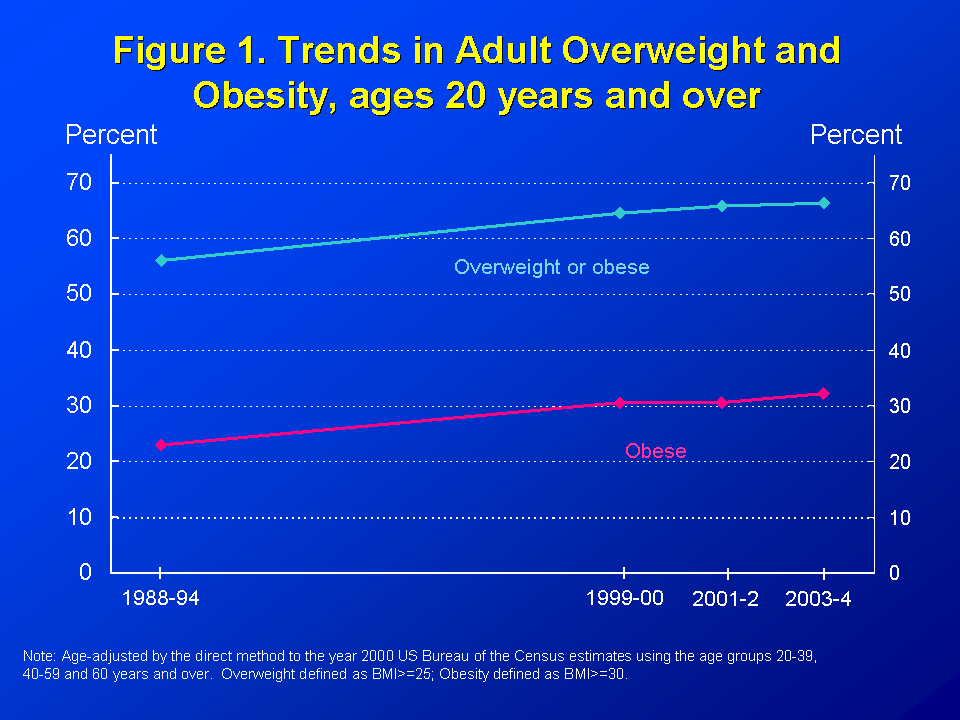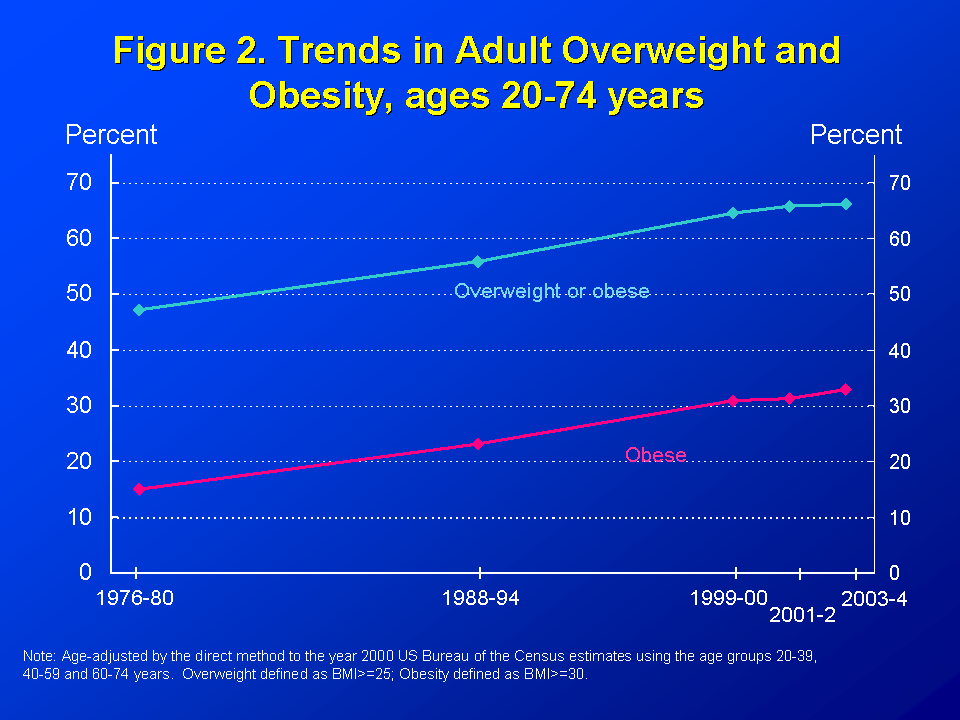Prevalence of Overweight and Obesity Among Adults: United States, 2003-2004
Results from the 2003-2004 National Health and Nutrition Examination Survey (NHANES), using measured heights and weights, indicate that an estimated 66 percent of U.S. adults are either overweight or obese as shown in table 1. One of the national health objectives for 2010 is to reduce the prevalence of obesity among adults to less than 15 percent. However, the NHANES 2003-2004 data for persons age 20 years and over suggest an increase in the proportion of obese adults in the United States, where the estimated age-adjusted prevalence moved upward from a previous level of 23 percent in NHANES III to a new level of approximately 32 percent.
Body mass index (BMI), expressed as weight/height2 (BMI; kg/m2), is commonly used to classify overweight (BMI 25.0-29.9) and obesity (BMI greater than or equal to 30.0) among adults (age 20 years and over). Because NHANES II did not include individuals over 74 years of age, age-adjusted prevalence estimates for adults age 20-74 years were compared in the NHANES surveys. There were notable increases in the prevalence of persons who were either overweight or obese (BMI greater than or equal to 25.0) in the last 25 years, as shown in table 2. Most of this increase was attributable to increases in the obese category (BMI greater than or equal to 30.0), whereas only minor increases occurred in the prevalence of persons who are overweight but not obese (BMI 25.0-29.9).
NHANES used a stratified, multistage, probability sample of the civilian, U.S. noninstitutionalized population. A household interview and a physical examination were conducted for each survey participant. During the physical examination, conducted in mobile examination centers, height and weight were measured as part of a more comprehensive set of body measurements. These measures were taken by trained health technicians, using standardized measuring procedures and equipment. Observations for pregnant women and for persons missing a valid height or weight measurement were not included in the data analysis.
Body mass index (BMI), expressed as weight/height2 (BMI; kg/m2), is commonly used to classify overweight (BMI 25.0-29.9), obesity (BMI greater than or equal to 30.0) and extreme obesity (BMI greater than or equal to 40) among adults (age 20 years and over). It is possible to look at trends over a longer time period for adults age 20-74 years (NHANES I & II did not include individuals over 74 years of age). Although the prevalence of obesity has more than doubled since 1980, the prevalence of overweight has remained stable over the same time period. table 2.
Figures
Figures 1 and 2 contain trend data from tables 1 and 2.


Tables
Table 1. Age-adjusted* prevalence of overweight and obesity among U.S. adults among U.S. adults, age 20 years and over
| NHANES III 1988-94 n=16,679 |
NHANES 1999-2000 n=4,117 |
NHANES 2001-02 n=4,413 |
NHANES** 2003-04 n=4,431 |
|
|---|---|---|---|---|
| Overweight or obese (BMI greater than or equal to 25.0) | 56.0 | 64.5 | 65.7 | 66.3 |
| Obese (BMI greater than or equal to 30.0) | 22.9 | 30.5 | 30.6 | 32.2 |
* Age-adjusted by the direct method to the year 2000 U.S. Bureau of the Census estimates using the age groups 20-39, 40-59, and 60 years and over.
** Crude estimates (not age-adjusted) for 2003-4 are 66.5% with a BMI >= 25 and 32.3% with a BMI >= 30.
Table 2. Age-adjusted* prevalence of overweight and obesity among U.S. adults, age 20-74 years**
| NHANES II 1976-80 n=11,765 |
NHANES III 1988-94 n=14,468 |
NHANES 1999-2000 n=3,603 |
NHANES 2001-02 n=3,916 |
NHANES 2003-04 n=3,756 |
|
|---|---|---|---|---|---|
| Overweight or obese (BMI greater than or equal to 25.0) | 47.0 | 55.9 | 64.5 | 65.7 | 66.2 |
| Obese (BMI greater than or equal to 30.0) | 15.0 | 23.2 | 30.9 | 31.3 | 32.9 |
* Age-adjusted by the direct method to the year 2000 U.S. Bureau of the Census estimates using the age groups 20-39, 40-59, and 60-74 years.
** NHANES II did not include individuals over 74 years of age, thus trend estimates are based on age 20-74 years.
For more detailed estimates see:
- Flegal KM, Carroll MD, Ogden CL, Johnson CL. Prevalence and trends in obesity among US adults, 1999-2000. JAMA 288:1723-7. 2002.
- Ogden CL, Carroll MD, Curtin LR, McDowell MA, Tabak CJ, Flegal KM. Prevalence of overweight and obesity in the United States, 1999-2004. JAMA 295:1549-1555. 2006.
- Page last reviewed: November 6, 2015
- Page last updated: December 23, 2009
- Content source:


 ShareCompartir
ShareCompartir